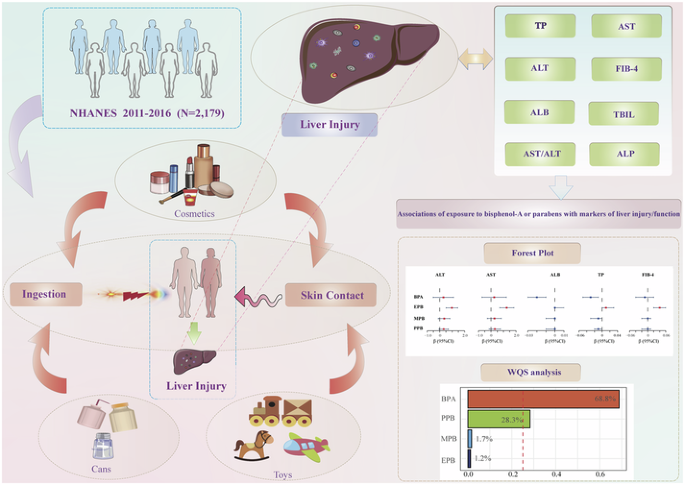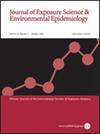2011-2016 年 NHANES 调查中美国成年人接触双酚 A 或对羟基苯甲酸酯与肝损伤/功能标志物的关系。
IF 4.7
3区 医学
Q2 ENVIRONMENTAL SCIENCES
Journal of Exposure Science and Environmental Epidemiology
Pub Date : 2024-07-17
DOI:10.1038/s41370-024-00704-8
引用次数: 0
摘要
背景:双酚 A(BPA)和对羟基苯甲酸酯(parabens)是常见的干扰内分泌的化合物(EDCs),被广泛应用于全球消费品中,并广泛存在于环境中:本研究旨在全面探讨尿液中双酚A/对羟基苯甲酸酯水平与肝损伤/功能指标之间的相关性:在这项横断面研究中,我们使用了美国国家健康与营养调查(NHANES)2011 年至 2016 年的数据。暴露变量为尿液中的双酚 A 和四种尿液中的对羟基苯甲酸酯[对羟基苯甲酸甲酯 (MPB)、对羟基苯甲酸乙酯 (EPB)、对羟基苯甲酸丙酯 (PPB) 和对羟基苯甲酸丁酯 (BPB)],结果变量为肝功能/肝损伤指标[丙氨酸氨基转移酶 (ALT)、天门冬氨酸氨基转移酶 (AST)、AST/ALT、白蛋白 (ALB)、总蛋白 (TP)、总胆红素 (TBIL)、碱性磷酸酶 (ALP) 和纤维化-4 指数 (FIB-4)]。采用多元线性回归和加权量化和(WQS)回归分析分别探讨了个体/综合暴露变量与肝损伤/功能指标之间的关系。此外,还采用了分层分析来检测受年龄和性别影响的关联:共有 2,179 名成年人符合本次分析的条件。多变量线性回归分析显示,EPB 与 AST、ALT、TP 和 FIB-4 评分呈正相关,而 BPA 与 TP 和 ALB 呈负相关。在女性和中年亚组中,尿液中的对羟基苯甲酸酯对肝脏不良结果(谷草转氨酶和谷丙转氨酶)的影响显著。此外,WQS 分析表明,四种化合物的混合物与 ALB 呈负相关。双酚 A 对血清 ALB 浓度的影响最大(权重 = 0.688):本研究提供了新的证据,证明双酚 A 或某些对羟基苯甲酸酯与多种肝损伤/肝功能指标之间存在显著关联。我们发现,尿液中的双酚 A 浓度越高,肝功能越差。暴露于高EPB/PPB比率与肝损伤的生物标志物显著相关。本文章由计算机程序翻译,如有差异,请以英文原文为准。


Associations of exposure to bisphenol-A or parabens with markers of liver injury/function among US adults in NHANES 2011–2016
Bisphenol-A (BPA) and parabens are common endocrine-disrupting compounds (EDCs) that are used extensively in consumer products worldwide and are widely found in the environment. The purpose of this study was to comprehensively explore the correlations between urinary BPA/parabens levels and liver injury/function markers. In this cross-sectional study, we used National Health and Nutrition Examination Survey (NHANES) data from 2011 to 2016. The exposure variables were urinary BPA and four urinary parabens [methylparaben (MPB), ethylparaben (EPB), propylparaben (PPB), and butylparaben (BPB)], while the outcome variables were indicators of liver function/injury [alanine aminotransferase (ALT), aspartate aminotransferase (AST), AST/ ALT, albumin (ALB), total protein (TP), total bilirubin (TBIL), alkaline phosphatase (ALP), and the fibrosis-4 index (FIB-4)]. Multiple linear regression and weighted quantile sum (WQS) regression analyses were applied to explore the relationships between the individual/combined exposure variables and the liver injury/function indicators, respectively. Furthermore, stratified analysis was employed to detect the associations influenced by age and sex. A total of 2,179 adults were eligible for the present analysis. Multivariate linear regression analysis revealed positive associations of EPB with AST, ALT, TP, and FIB-4 scores and negative associations of BPA with TP and ALB. The effects of urinary parabens on adverse outcomes in the liver (AST and ALT) were significant in the female and middle-aged subgroups. In addition, the WQS analysis revealed that the mixture of four compounds was negatively associated with ALB. BPA had the greatest effect on the serum ALB concentration (weight = 0.688).
求助全文
通过发布文献求助,成功后即可免费获取论文全文。
去求助
来源期刊
CiteScore
8.90
自引率
6.70%
发文量
93
审稿时长
3 months
期刊介绍:
Journal of Exposure Science and Environmental Epidemiology (JESEE) aims to be the premier and authoritative source of information on advances in exposure science for professionals in a wide range of environmental and public health disciplines.
JESEE publishes original peer-reviewed research presenting significant advances in exposure science and exposure analysis, including development and application of the latest technologies for measuring exposures, and innovative computational approaches for translating novel data streams to characterize and predict exposures. The types of papers published in the research section of JESEE are original research articles, translation studies, and correspondence. Reported results should further understanding of the relationship between environmental exposure and human health, describe evaluated novel exposure science tools, or demonstrate potential of exposure science to enable decisions and actions that promote and protect human health.

 求助内容:
求助内容: 应助结果提醒方式:
应助结果提醒方式:


